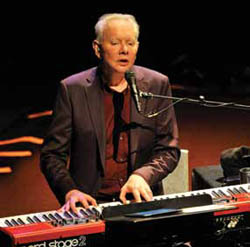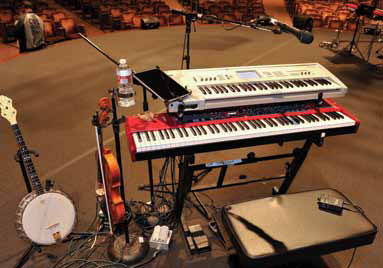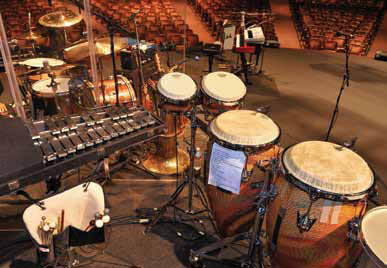
Making Decisions
Jackson prefers a clean, quiet stage – all in-ears, no wedges.
In response, Froula deployed beyerdynamic IMS-900 RX/TE-9000 TX RF systems feeding Future Sonics MG6 Pro in-ear monitors, a choice based on their armature-free single driver design.
“That makes a big difference in delivering natural sounding mids and highs, along with huge low-end reproduction,” he states.
While Allison Cornell (keyboards/viola/banjo/multilingual vocals) and Hadjopoulos – both veterans of previous Jackson tours – and Jackson himself knew exactly what they wanted, there was a little more interpretation going on with the rest of the band.
“They weren’t as familiar with what they wanted, versus what they needed, versus what they thought they wanted,” Froula says, “but once they started performing, the in-ears became a part of who they were on stage, which is the way it should be. And Joe, he was looking over the band smiling, pleased that everyone was doing what came naturally and the improvisation breaks kept flowing.”
In addition to percussion, drums, keyboards, violin, viola and Adam Rogers’ electric and acoustic guitars, Jesse Murphy plays electric and upright bass and Tuba, Jackson plays accordion and Cornell plays banjo. Ensuring the band could do what came naturally, and that the eclectic mix of instruments sounded natural both in the player’s IEMs and in the house, played a part in the choice of microphones.

Froula’s predominant selections are from beyerdynamic. “As a rule, for drums, I go with Opus models because they sound really good and have an innovative mounting system that clamps on drums very nicely and allows for a full-sized XLR coming off the barrel connector. They’re clean, reliable, and I’ve used them on drums for the better part of 10 years.”
Both drums and percussion received similar treatment: Opus 88s and 87s on snare, toms, timbale and bongos, and beyerdynamic MC 930s for hi-hat, overheads and various “toys and tinkles.” Cowan went with a Sennheiser e 602 on Nate Smith’s kick – part of a vintage kit that has it’s own peculiarities, Froula notes. Additionally, a Shure SM98 was applied for Hadjopoulos’ glockenspiel.
More beyerdynamic could be found on other instruments: Opus 62s on banjo and on Jackson’s accordion, TG-X 60s for backing vocals and MCE 86s for house left/right ambient mics. Violin was handed with a combination of an MCE 10 clip-on mic and an LR Baggs direct box, but the viola was LR Baggs direct only.
“Allison’s choice,” Froula explains. “The way she configures the DI sounds great. As far as tone and EQ, she’s got it down.”

Radial JDIs handled stereo keyboard mixes and, in tandem with an internal Fishman pickup, acoustic guitar. The only amp in evidence – for electric guitar – was offstage in an isolation box and miked with a Sennheiser e 609 over the dome for the house and a Royer R-121 on the right edge of the cone for monitors.
Between electric/upright bass and tuba, Murphy had a lot going on, Froula notes. “On electric we used a TabFunkenwerk DI, and on upright a JDI and an Audio-Technica ATM350. On tuba, there’s a certain punch to brass at that frequency some mics don’t handle well. We tried a bunch of things and the last – probably the 10th mic we checked out – was a Sennheiser e 904 gaff-taped down the bell on a piece of foam. It wasn’t pretty, but it worked and was a method previously proved by George.”
Enjoyable & Engaging
In each case, it’s about choosing the right microphone for the instrument; an approach Froula and Cowan both adhere to. “I think that comes from my recording background,” Cowan says. “Whatever sounds good on a particular instrument on a particular day, we move forward with that.”
Nowhere is that approach more evident than when it’s applied to the most important instrument on stage, Jackson’s voice. “We’ve tried a number of microphones,” Cowan explains, noting that the Shure KSM9 has provided the answer. Specifically, it treats the mid range tone of Jackson’s voice very well and allows both engineers to reproduce his signature tone while applying very little in terms of EQ.
The approach also fits in perfectly with Jackson’s approach to his music. Like Duke Ellington, Jackson is known for taking pleasure in showcasing the individual voices of the musicians he works with, but also for recognizing the talents and art of the technicians who strive to reproduce those voices accurately, both for the band on stage and for their audiences.
“Joe spends a good deal of time rehearsing to get it right,” Cowan concludes. “He has high standards and so we generally have time to work out the kinks before we all get thrust into the limelight. He gives us the time to experiment, and that’s awesome. We truly appreciate working with him because it’s always enjoyable and engaging, night after night.”
Based in Toronto, Kevin Young is a freelance music and tech writer, professional musician and composer.
